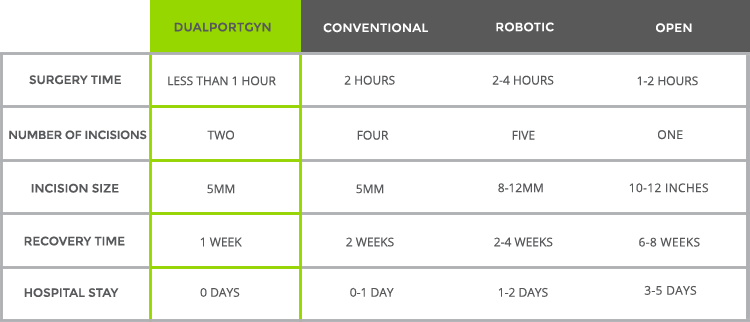
Resection of Endometriosis


A skilled surgeon who is able to remove all of the instances of endometriosis (or endometriomas on the ovary) in the pelvic and abdominal regions can help women find relief.

What is endometriosis excision?
Endometriosis excision (or resection of endometriosis) refers to the removal of lesions of endometriosis, which are implants of cells similar to the uterine lining located outside of the uterus. Learn more about endometriosis.
This is a type of conservative management of endometriosis. The goal is to improve symptoms while preserving the uterus, tubes and ovaries, as much as possible.
Facts to Know:
Endometriosis excision is usually done for women who are not yet finished with childbearing or who have milder disease.
This surgery can improve pain – 80 percent of women reported improvement in their symptoms six months after surgery – but it does not cure endometriosis. Forty to 80 percent of women will have a recurrence of pain within two years of surgery.
Why would a woman need to undergo a endometriosis excision?
Women who have endometriosis, but would like to retain their uterus or get pregnant in the future, may be good candidates for removal of endometriosis.
What are the major risks associated with endometriosis excision?
Like any surgical procedure, endometriosis removal is associated with certain risks. These may include excessive blood loss, an infection requiring antibiotic treatment, developing scar tissue, and childbirth complications.
What happens during laparoscopic endometriosis excision?
During a laparoscopic excision, a thin telescope-like camera is inserted into the navel to evaluate the pelvis. Usually one to two additional 5 mm incisions in the lower abdomen are made to access the pelvis, and the endometriotic implants can be cut out and removed. For women with severe endometriosis and extensive pelvic adhesions (internal scar tissue), it is sometimes not possible to completely resect all of the endometriosis, as it may be deeply involved with vital structures such as the ureter or rectum.
DualPortGYN for endometriosis resection or excision is a pioneering new procedure, developed at The Center for Innovative GYN Care, that uses only two, 5 millimeter incisions. One incision is placed at the belly button and the other is at the bikini line. With these incisions, most GYN procedures like endometriosis excision can be performed safely in less than one hour.
How long is recovery?
Recovery times vary from one week to 6-8 weeks depending on the type of surgery. This chart details recovery time for a variety of GYN surgical techniques. It will also depend on the technique used for surgery. An open abdominal method, which uses an eight-inch incision at the bikini line, recovery will take much longer than a laparoscopic method with much smaller incisions.

How does DualPortGYN work?
- Clearer view and fewer complications – DualPortGYN uses a technique known as retroperitoneal dissection (RPD), originally developed to remove cancerous tissue. By going behind (retro) the lining (peritoneal), the surgeon completely visualizes all of the anatomy of the pelvis, and avoids complications such as excessive bleeding, bladder injury, injury to the ureter and bladder. RPD allows surgeons to map the organs and arteries in the pelvis, much like a GPS system, reducing the time of the procedure and avoiding injury to the pelvic structures.
- More convenience – In many situations, the surgery is performed on an outpatient basis allowing patients to go home the same day and return to most normal activity in approximately one week.
For women who are finished having children, or who have not responded to conservative management, such as resection of endometriosis, a hysterectomy is recommended for longer-term relief.
What should I ask my doctor or OB-GYN if he/she recommends endometriosis excision?
Before undergoing surgery, you will likely have many questions for your doctor or OB-GYN. Below are some recommended questions to ask – and background information to help you weigh the answers. You can also download a printable version of these questions.
HOW WILL THE SURGERY BE PERFORMED?
First, if your physician recommends a hysterectomy, be sure to ask what other more conservative options are available to treat your symptoms if you would like to have children in the future. Depending on the severity of endometriosis, other surgical options exist such as minimally invasive endometriosis excision.
If a hysterectomy is the right choice for you, there are many options to consider. Sixty percent of hysterectomies in America are still performed as open abdominal surgeries. This procedure can result in severe pain, higher complication rates, and a longer recovery period than new minimally invasive procedures. Other clinics or hospitals use robotics, which require more incisions and more scarring. If your physician recommends these options, consider seeking out a second opinion before agreeing to the surgery.
HOW MANY TIMES HAVE YOU PERFORMED THIS SURGERY?
When it comes to any form of surgery, training, skill and practice matter, which is why GYN surgeons who specialize in minimally invasive surgery are the most qualified. The reality is that OB-GYNs are highly skilled obstetric practitioners, but very few perform GYN surgeries often enough to be surgical specialists. This is borne out by studies, which find that GYN surgery is commonly a secondary component of what an OB-GYN does.
WHAT HAVE OTHER PATIENTS EXPERIENCED AFTER THIS PROCEDURE?
Robotic, open and conventional laparoscopic GYN surgeries can lead to longer recovery times, increased blood loss and larger scars than newer procedures. Make sure your surgeon is trained in the latest minimally invasive techniques, such as The Center for Innovative GYN Care’s DualPortGYN, that prevent injury to the pelvic structures and minimize blood loss – resulting in reduced complication rates and improved recovery times.
HAVE YOU RECEIVED FELLOWSHIP TRAINING IN MINIMALLY INVASIVE GYN SURGERY?
While most OB-GYNs are highly trusted generalists, they spend most of their time focusing on obstetrics and basic GYN care and therefore, perform specialized GYN surgeries rarely. Be sure to choose a surgeon who has received comprehensive training and performs many endometriosis resections or minimally invasive hysterectomies to treat endometriosis each year.
WILL POWER MORCELLATION BE USED TO REMOVE TISSUE DURING THE SURGERY?
This is an important question when considering gynecological surgery. The reason is because hidden uterine cancer called sarcoma can be spread through the abdomen and pelvis during surgery when the small motorized blades in these devices spin at high speed to cut the tissue into small strips for removal. The Food and Drug Administration (FDA) now requires all surgeons to tell women in advance if the surgery involves a power morcellator and to get written consent before the surgery takes place.
WILL ROBOTICS BE USED TO ASSIST WITH THE SURGERY?
Although the American Medical Association and other leading medical societies have issued statements discouraging robotic techniques due to much higher costs to patients without any medical advantages, robotics continue to be used in GYN surgeries. This is because robotic procedures “enable” an OB-GYN not well trained in laparoscopic GYN surgical techniques to complete a procedure through a “minimally invasive” approach. This is why women need to ask if robotics will be used during a GYN surgery and to seek a specially trained surgeon able to perform the latest minimally invasive surgical techniques for endometriosis, such as DualPortGYN and retroperitoneal dissection, that do not use robotics.
WHAT IS MY ANTICIPATED RECOVERY TIME?
New minimally invasive GYN surgical techniques require, on average, only a week to recover. Other procedures such as open abdominal surgery can take up to 8 weeks.
WHAT ARE MY OTHER SURGICAL OPTIONS?
Ask your physician if he or she is aware of new, minimally invasive procedures.


